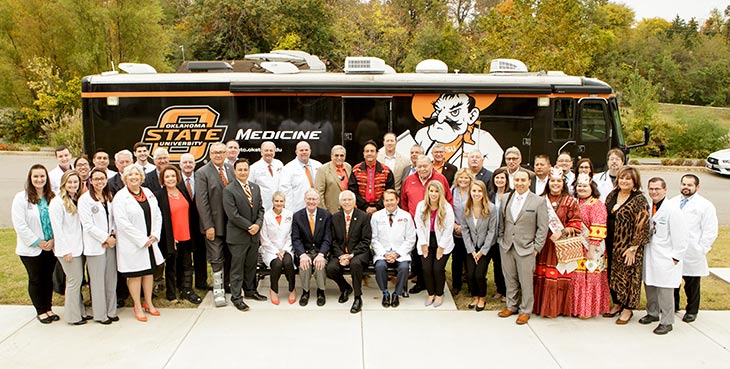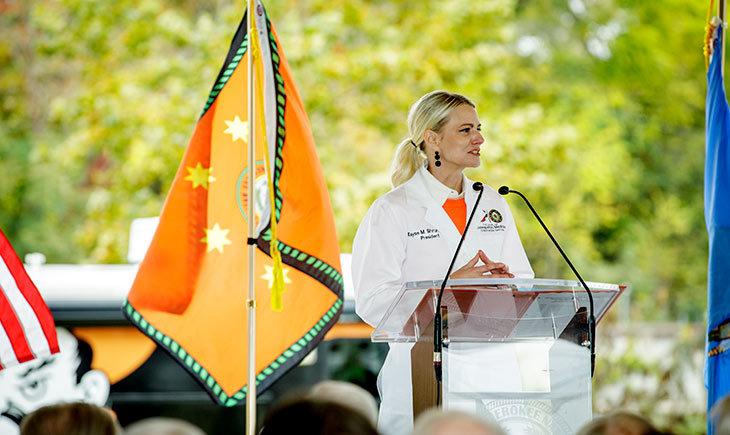
Nation’s first tribally affiliated college of medicine established between Cherokee Nation and Oklahoma State University Center for Health Sciences
Wednesday, October 31, 2018

The Cherokee Nation and Oklahoma State University Center for Health Sciences today announced the establishment of the nation’s first college of medicine to be located at a tribal health facility in Tahlequah, Oklahoma, set to open in 2020.
The new OSU College of Osteopathic Medicine at the Cherokee Nation will be an additional location of the OSU College of Osteopathic Medicine located in Tulsa, Oklahoma. OSU College of Osteopathic Medicine has received approval from the American Osteopathic Association's Commission on Osteopathic College Accreditation for an additional location in Tahlequah, pending a satisfactory site visit in the spring of 2020.
Current plans call for the enrollment of an inaugural class of 50 students, starting in the fall of 2020 with a total of 200 students when fully operational. The new medical college will be located at the W.W. Hastings Hospital campus, 100 S. Bliss Ave, and will occupy approximately 60,000 square feet. Renovation work to accommodate the new medical college will take place once existing patient services have been relocated to a new outpatient health facility on the same medical campus. The new 469,000-square-foot outpatient health facility is expected to be complete in 2019.

“The establishment of the OSU College of Osteopathic Medicine at the Cherokee Nation is the culmination of years of work and is part of our steadfast commitment to making Cherokee Nation’s health care not only the best in Indian country, but the best in the state of Oklahoma,” said Bill John Baker, Principal Chief of the Cherokee Nation. “Recruiting primary care physicians to practice within the Cherokee Nation’s 14-county jurisdiction remains a constant struggle. We admire and support OSU Center for Health Sciences’ efforts to populate rural Oklahoma with doctors from rural Oklahoma. That mission will create healthier families and communities in northeast Oklahoma and improve the lives of Cherokees for the next seven generations.”
“The creation of the nation’s first tribally affiliated medical school falls directly in line with Oklahoma State University’s mission as a land grant university,” noted OSU President Burns Hargis. “Chief Baker and the Cherokee Nation share a mission with the OSU College of Osteopathic Medicine to provide primary care physicians for rural and medically underserved areas of the state. What better way to achieve those goals than partnering together to bring a new center of medical learning to the Cherokee people?”
“Chief Baker and the Cherokee Nation understand the severe physician shortage crisis in rural Oklahoma and share our vision of populating rural and tribal areas of our state with OSU-trained primary care physicians,” said Kayse Shrum, D.O., OSU-CHS president and OSU College of Osteopathic Medicine dean. “Our partnership with the Cherokee Nation has deepened over the past 12 years. In 2006, our medical students started completing clinical rotations at W.W. Hastings Hospital. In 2009, we established a family medicine residency program in Tahlequah. We now have the opportunity to take this partnership to the next level through the creation of a new college of medicine. I can’t think of a better way to attract and train primary care physicians for rural and underserved Oklahoma than to train them in rural communities such as Tahlequah.”
“This new site will give our young people a place to learn and to become doctors while staying close to home,” Baker said. “Having medical students hone their skills right here in Tahlequah is a win-win for the Cherokee Nation. Our people will have access to doctors, making northeast Oklahoma a great place to work, to live and to raise a family.”

The Cherokee Nation health system is a closed system, like the VA system, meaning it serves a single population – in this case, Native Americans. That means many patients exclusively utilize the Cherokee Nation health care system from birth to death and can be monitored for their long-term health. This new partnership will also yield groundbreaking research on health issues affecting Native American populations: data analytics, population health, precision medicine and epigenetics. The list of potential research collaboration is endless. Lives will be made better because of discoveries made possible through this partnership.
Nationally, only 0.2 percent of medical school students are Native American. At OSU-COM that percentage is as high as 16 percent some years.
A large number of OSU-trained physicians are already practicing medicine in northeast Oklahoma because of the success of the OSU residency programs in Tahlequah. Data shows that each physician brings about $1 million in economic stimulus to a community. The combination of better access to medical care and the economic boost is a huge win for these communities.
OSU Center for Health Sciences has already begun implementing recruiting strategies
to
identify biomedical and clinical faculty and potential students for the new site.
OSU-CHS plans to leverage its long-established relationship with Northeastern State
University in Tahlequah to attract students. NSU is already a part of OSU-CHS’ 3+1
Program, which allows rural students to gain admission into OSU-COM after their sophomore
year of college and start medical school following the completion of their junior
year. The process streamlines the combined eight-year undergraduate/medical education
into seven years.
Oklahoma suffers from a chronic and worsening physician shortage. OSU Center for Health Sciences estimates the new site will have in total up to 200 medical students in training by the time the first class graduates in 2024.
